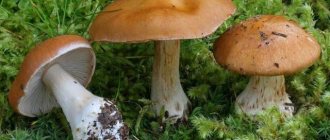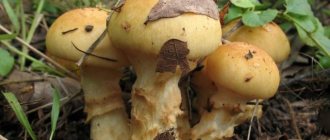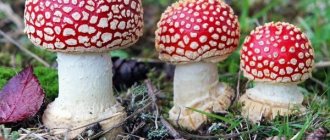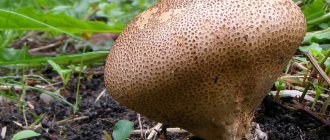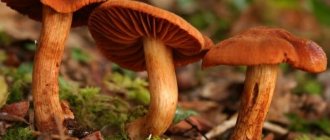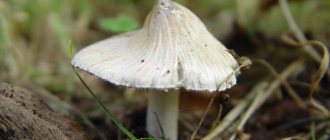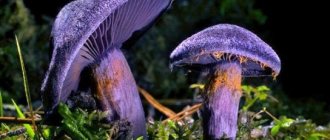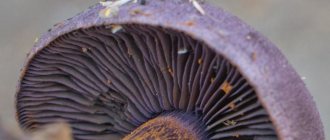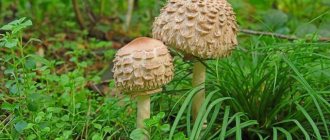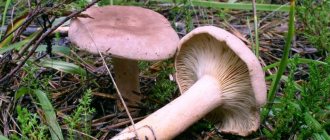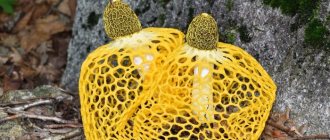| Cortinarius rubellus | |
| Scientific classification | |
| Kingdom: | Mushrooms |
| Subdivision: | Basidiomycetes |
| Class: | Agaricomycetes |
| Order: | Agaricales |
| Family: | Cortinariaceae |
| Genus: | Cortinarius |
| Kinds: | C. rubellus |
| Binomial name | |
| Cortinarius rubellus Cook, 1887 | |
| Synonyms | |
| Cortinarius orellanoides Rob. | |
| Cortinarius rubellus | |
| Mycological characteristics | |
| gills on hymenium | |
| the cap is conical or convex | |
| the hymenium is fused | |
| leg is naked | |
| seal spore is cream to yellow | |
| Edibility: poisonous | |
Cortinarius rubellus
, commonly known as
death's web
, is a species of mushroom in the family Cortinariaceae, native to Europe and North America. Within the genus, it belongs to a group known as Orellani, all of which are highly toxic - eating them leads to kidney failure, which is often irreversible. The mushroom is usually yellowish-brown or brown in color.
Systematics, characteristics and description of the structure
The most beautiful cobweb (Latin name Cortinarius rubellus) is a lamellar mushroom representing the genus Cobwebs, family Cobwebs, class Agaricomycetes.
Another name is reddish cobweb. The size of the cap in adult specimens varies from 3 to 8 cm in diameter. Its shape at a young age is conical, then it becomes flat or completely convex, with a small blunt tubercle located in the center. The surface is velvety, dry, sometimes scaly at the edges, the color ranges from crimson-brown to reddish and brown. The lower part of the cap (hymenophore) consists of sparse, thick plates, attached to it, carrot-brown in color in young mushrooms and rusty-brown in mature ones.
The pulp is yellow-orange, has no taste, a faint, rare odor, sometimes absent.
The leg, 5 to 12 cm long and 0.5 to 1.5 cm thick, has a cylindrical shape, slightly thickening towards the bottom. Its surface is fibrous, orange-brown in color, with remnants of a blanket in the form of belts.
IMPORTANT!
The most beautiful cobweb is a poisonous mushroom. Contains orellanin, a slow-acting toxin that mainly affects the kidneys, as well as the musculoskeletal system and respiratory organs. However, until the 50s of the last century, this species was considered conditionally edible, until in 1957, after numerous recorded cases of poisoning, it was classified as deadly.
Taxonomy
English naturalist Mordecai Cubitt Cook described Cortinarius rubellus
in 1887 from material collected by Dr Carlisle at Orton Moss near Carlisle in north-west England.[1]
However, this name was rarely used before 1980.[2] Cortinarius orellanoides
was described by Henry in 1937 from fungi growing under ferns (
Pteridium aquilinum
) and beech in France, and Robert Kühner and Henri Romagnesi described
C. speciosissimus
(originally
C. speciosus
, but this name had already been given to another species of cobweb) from fungi growing in moss among
Vaccinium
in the pine and spruce forests of France and Switzerland's Jura.[3]
Cortinarius rainierensis
, described in 1950 by Alex H. Smith and Daniel Elliott Stuntz from materials collected at Mount Rainier National Park in the United States,[4] it is a synonym.[5]
Klaus Hoyland reviewed the material from C. orellanoides
and
C. speciosissimus
and determined that the fungi and spores were identical.
The only difference was that C. orellanoides
grew in beech and
C. speciosissimus
preferred conifers, but he also found the latter species growing under beech in Norway.
He concluded that the name should be C. orellanoides
, since it was an old name.[3]
Hoyland and others noted that C. rubellus
was probably also of the same species.[2]
However, Gasparini doubted this, since in Cook's original illustrations of C. rubellus
, he noted that the spores were triangular or fig-shaped and did not match the descriptions of
C. orellanoides
or
C. speciosissimus
.[6]
In 2007, Bruno Gasparini proposed retaining the name C. speciosissimus
compared to other names, since it was mostly known by that name between 1953 and 1980, and there was some doubt as to which names were legitimate.
Both C. rubellus
and
C. orellanoides
lacked a type specimen, and it was possible that the description of
C. rubellus
might also refer to
Cortinarius morrisii
.[2] As of 2009, there was no consensus on this proposal.[7]
C. rubellus
is one of seven highly toxic species that make up Orellani, a subgenus within the genus
Cortinarius
.[6]
How to distinguish false doubles of a poisonous mushroom
Representatives of the Cobweb genus are numerous and very similar in appearance. There are also mushrooms that are not related to it, but are similar to the beautiful cobweb.
The main twins are presented in the table:
| Name of the mushroom | Description (differences) | Habitats |
| Mountain gossamer | Dangerous poisonous mushroom. The leg is light yellow in color, tapers towards the bottom and the rings of the remains of the bedspread are not visible on it | Broadleaf forests next to oaks and beeches |
| Edible cobweb or fat plant | Edible. The cap bends downward at the edges; with age, the middle of the cap becomes flat or depressed, without a tubercle. The surface is damp. The color contains white and gray shades. The leg is straight and light. There is no radish smell. | Dry pine forests |
| Slime cobweb | Conditionally edible. The cap size is up to 12 cm, the surface is covered with mucus. The leg is long and thin, up to 20 cm, light, with a blue tint. Rings and lumps may be visible on the stem. | Coniferous and mixed forests |
| Cobweb spider brilliant | The most dangerous poisonous mushroom in the genus of cobwebs. The cap is bright orange, slimy. | Coniferous forests. Very rare |
| Tuberous honey fungus | Edible. It is distinguished by a pale yellow leg without bands. The color of the plates of mushrooms is also different; honey mushrooms are white or light yellow, while cobwebs are bright red-brown. | Coniferous and mixed forests |
| Wet purple | Edible. The cap is red-brown, shiny, slimy. In young mushrooms, the center of the cap has purple tints; with age, it fades and evens out. The leg is cylindrical, often curved, fibrous, sticky. | Coniferous and mixed forests. Forms mycorrhiza with pine and birch. |
Distribution and habitat
C. rubellus
has been recorded under high temperature conditions in subalpine forests throughout the northern hemisphere, including subalpine coniferous forests in the Yatsugatake Mountains in Yamanashi Prefecture, Central Japan.[10]
In North America, it is found in British Columbia and western Washington, especially Mount Rainier National Park.[11] C. rubellus
is also found in the northern British Isles, usually in damp areas of coniferous or mixed coniferous-deciduous woodland, although infrequently.[12]
Signs of poisoning and first aid
The complex polypeptide orellanin, a toxin contained in the spider web, is not eliminated after heat treatment, changing the acidity of the environment and drying. The main organ that is affected by it is the kidneys. Under its influence, tissue structure is destroyed and organ function is disrupted.
Even a small amount of poison can cause serious harm to the body: 40 g of fresh mushrooms can lead to death.
The peculiarity of orellanine poisoning is the duration of symptoms. From the moment of eating mushrooms until the first signs appear, it can take from 7 to 14 days.
Symptoms of poisoning:
- strong thirst;
- dryness and burning in the mouth;
- nausea;
- headache;
- intense pain in the kidney area;
- feeling of coldness in the extremities.
Death occurs due to acute renal failure, which occurs rapidly and does not respond even to restraining treatment.
If the outcome is not fatal, with prolonged nephropathy the result is chronic renal failure.
The unusually long latent period of action of orellanine makes diagnosis, first aid and treatment of poisoning difficult. Therefore, you should treat mushrooms with extreme caution and refrain from eating even similar edible species. They are especially dangerous for children and the elderly.
Toxicity
Danger of Cortinarius rubellus
was first discovered in 1972 in Finland, where four cases of poisoning occurred, two of which resulted in irreversible kidney failure.[13]
In 1979, three people on holiday in the north of Scotland were poisoned.[12] mistaking it for a fox.[9] Two of the three required kidney transplants.[12] Twenty-two people were poisoned in Sweden between 1979 and 1993, nine of whom required kidney transplants. end-stage renal disease (ESRF). Among the edible species of mushrooms, they considered Craterellus tubaeformis
and
Hygrophorus
species, as well as chanterelles, to be mushrooms.[14]
Craterellus tubaeformis
can be distinguished by its funnel-shaped cap and ridges on the underside of the cap rather than its gills.[15] In 1996, a man in Austria ate it while looking for magic mushrooms.[16]
Nicholas Evans, author of The Horse Whisperer
, his wife Charlotte Gordon Cumming, and two other relatives were accidentally poisoned in September 2008 after consuming deadly web caps they had collected on holiday.
Evans suggested that they were porcini mushrooms, but failed to note that the mushrooms had gills, not pores. All four victims were informed that they would require kidney transplants in the future. Several years later, Evans received a kidney donated by his daughter Lauren.[17] The other three eventually received transplants after some searching for donors, despite Charlotte having only eaten three mouthfuls of mushrooms; they were instrumental in the creation of the charity Give a Kidney.[ citation needed
]
Definitioner
Basidia (Basidia)
Lat. Basidia. A specialized structure of sexual reproduction in fungi, unique to basidiomycetes. Basidia are terminal (end) elements of hyphae of various shapes and sizes, on which spores develop exogenously (outside).
Basidia vary in structure and method of attachment to hyphae.
Based on the position relative to the axis of the hyphae to which they are attached, three types of basidia are distinguished:
Apical basidia are formed from the terminal cell of the hypha and are located parallel to its axis.
Pleurobasidia are formed from lateral processes and are located perpendicular to the axis of the hypha, which continues to grow and can form new processes with basidia.
Subbasidia are formed from a lateral process turned perpendicular to the hyphal axis, which stops growing after the formation of one basidium.
Based on morphology:
Holobasidia are single-celled basidia, not divided by septa (see Fig. A, D).
Phragmobasidia are divided by transverse or vertical septa, usually into four cells (see Fig. B, C).
By type of development:
The heterobasidium consists of two parts - the hypobasidium and the epibasidium developing from it, with septations (see Fig. C, B) or without them (see Fig. D).
Homobasidia is not divided into hypo- and epibasidia and in all cases is considered to be holobasidium (Fig. A).
The basidium is the site of karyogamy, meiosis, and the formation of basidiospores. Homobasidy, as a rule, is not functionally divided, and meiosis follows karyogamy. However, the basidia can be divided into probasidium, the site of karyogamy, and metabasidium, the site of meiosis. Probasidium is often a resting spore, for example in rust fungi. In such cases, the probasidium germinates into a metabasidium, in which meiosis occurs and on which basidiospores are formed (see Fig. E).
See Karyogamy, Meiosis, Hypha.
Pileipellis
Lat. Pileipellis, skin - a differentiated surface layer of the cap of agaricoid basidiomycetes. The structure of the skin in most cases differs from the inner flesh of the cap and may have a different structure. The structural features of pileipellis are often used as diagnostic characters in descriptions of fungal species.
Based on their structure, they are divided into four main types: cutis, trichoderma, hymeniderma and epithelium.
See Agaricoid fungi, Basidiomycete, Cutis, Trichoderma, Hymeniderma, Epithelium.
Kutis
The type of cap skin consists of creeping, ungelatinized hyphae located parallel to the surface. The surface of the cap looks smooth.
Lat. Cutis.
See Hypha.
Doubles and their differences
The most beautiful cobweb is easily confused with other mushrooms, both belonging to a similar family and having a completely different origin. Below are photos and descriptions of his doubles.
Tuberous honey fungus
Most often, the cobweb is confused with an edible mushroom - tuberous honey fungus or amillaria. Mushrooms are very similar to each other. They have almost the same size and shape. In addition, both honey fungus and spiderwort have a similar habitat and prefer spruce forests.
The differences lie, first of all, in color: honey mushrooms are lighter, they have ocher-colored belts on their legs. In addition, honey mushrooms have a fairly fleshy cap with a tubular hymenophore (the beautiful spiderwort has a lamellar one). You should also not forget about the mucus that traditionally covers honey mushrooms, which the fruiting bodies of the cobwebs do not possess. The gloss on their hat will not be slippery to the touch, but velvety.
Edible cobweb
Another name for the mushroom is fat mushroom. Unlike its poisonous relative, it has a thick and fleshy cap. The remaining parameters of the mushrooms are approximately identical. The habitat is also the same.
The color of the fat ones is also different from the beautiful spiderwort - they are lighter. In older fruiting bodies of the edible mushroom, the cap also becomes thinner, but there is still enough pulp left in it. In addition, its surface will always be watery.
In which regions is the mushroom listed in the Red Book?
The ability of the marsh plant to form mycorrhiza with different trees gives it the opportunity to grow almost anywhere in the world. Despite this, the mushroom is quite rare, which is why in many regions of Russia it ended up on the pages of the Red Book.
The exotic variety is protected in the Astrakhan, Vladimir, Vologda, Tambov, Yaroslavl, Novosibirsk, Oryol, Moscow, Murmansk and Leningrad regions. In addition, the mushroom received a special status in the Republic of Karelia, Komi, North Ossetia, Tatarstan, Khakassia, Altai Territory, Khanty-Mansi Autonomous Okrug and Chuvashia.
Plush web spider (Cortinarius orellanus)
- Other names for the mushroom:
- Mountain gossamer
- Cobweb orange-red
Other names:
Description: The plush web spider (Cortinarius orellanus) has a dry, matte cap, covered with small scales, 3-8.5 cm in diameter, at first hemispherical, then flat, with an inexpressive tubercle, orange or brown-red with a golden tint. All of them are distinguished by non-slip, always dry fruiting bodies, a felt-silky cap and a slender, not thickened stem. The plates are colored from orange to rusty brown.
Distribution: Plush cobweb is a relatively rare species. In some countries it has not yet been discovered. In Europe it grows mainly in autumn (sometimes at the end of summer) in deciduous and occasionally in coniferous forests. It forms mycorrhiza mainly with oak and birch. Most often appears on acidic soils. It is very difficult to learn to recognize this extremely dangerous mushroom, since there are many similar species; Because of this, even for a specialist, identifying the plush web spider is not an easy task.
Note:
The plush cobweb is deadly poisonous. Contains a toxic substance orellanin, which causes pathological changes in the kidneys. Signs of poisoning appear 3-14 days after eating the mushroom. The mushroom retains its toxic properties after boiling in water or drying.
The plush cobweb, like other types of cobwebs, was considered a harmless mushroom until I960. The prevailing opinion was that among the huge number of spider webs (more than 400 species grow in Europe alone), there are only bitter, inedible species and relatively tasty species that are suitable for food.
However, after frequent poisonings that took place in Poland, many of which turned out to be fatal, it was possible to establish that the culprit was the plush cobweb - a radish-smelling and pleasant-tasting mushroom. During chemical analysis, several poisonous compounds were found in its fruits - orellanine, cortinarine, benzoinine, etc. Eating this and other types of spider webs is especially dangerous because the first signs of poisoning do not appear immediately, but after quite a long time - from 3 to 24 days. Then there is a rapid deterioration in the person’s condition, impaired renal function and death.
